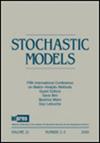具有延迟的Pólya–Eggenberger-urn模型的估计
IF 0.7
4区 数学
Q4 STATISTICS & PROBABILITY
引用次数: 0
摘要
摘要在本文中,我们介绍了一个由Pólya–Eggenberger-urn模型导出的新模型。该模型是通过考虑收集信息的延迟来定义的。该模型的数学公式是通过四个参数来完成的;第一结构中的球的数量(N 0),第一结构中白色球的数量,退出的球的颜色的奖励球数量(a),以及延迟的长度(i)。作为该模型中处理点估计的第一次尝试,我们在任何时候都将其中一个参数单独视为未知,条件是知道其他三个参数,并找到其估计。因此,我们为该模型引入了一个充分的估计量,并在其上获得了四个参数中每一个的最大似然估计量。此外,还计算了N0和W0的矩估计量。此外,对于其他参数,我们基于连续提款的相关系数获得估计量。为了评估所获得的估计量的性能并比较其准确性,我们对延迟Pólya-urn模型进行了五次模拟。用Matlab R2015b软件进行了仿真。根据仿真研究,矩法得到的估计量优于最大似然估计量。本文章由计算机程序翻译,如有差异,请以英文原文为准。
The estimation in Pólya–Eggenberger urn model with a delay
Abstract In this article, we introduce a new model derived from Pólya–Eggenberger urn model. This model is defined by considering a delay in collecting information. The mathematical formulation of this model is done through four parameters; the number of balls in the first structure (N 0), the number of white balls in the first structure (W 0), the number of rewarded balls of the color of the ball withdrawn (a), and the length of the delay (i). As the first attempt to deal with point estimation in this model, we consider at any time one of the parameters separately as unknown conditioned to knowing the other three parameters, and find its estimation. Accordingly, we introduce a sufficient estimator for this model, and found on it, obtain the maximum likelihood estimators for each of the four parameters. In addition, moment estimators for N 0 and W 0 are calculated. Also, for the other parameters, we obtain estimators based on the correlation coefficient of consecutive withdrawals. To evaluate the performance of the obtained estimators and compare their accuracy, we apply five simulations of the delayed Pólya urn model. The simulations have been done with the software Matlab R2015b. According to the simulation study, the estimators obtained from the method of moments are preferable to maximum likelihood estimators.
求助全文
通过发布文献求助,成功后即可免费获取论文全文。
去求助
来源期刊

Stochastic Models
数学-统计学与概率论
CiteScore
1.30
自引率
14.30%
发文量
42
审稿时长
>12 weeks
期刊介绍:
Stochastic Models publishes papers discussing the theory and applications of probability as they arise in the modeling of phenomena in the natural sciences, social sciences and technology. It presents novel contributions to mathematical theory, using structural, analytical, algorithmic or experimental approaches. In an interdisciplinary context, it discusses practical applications of stochastic models to diverse areas such as biology, computer science, telecommunications modeling, inventories and dams, reliability, storage, queueing theory, mathematical finance and operations research.
 求助内容:
求助内容: 应助结果提醒方式:
应助结果提醒方式:


